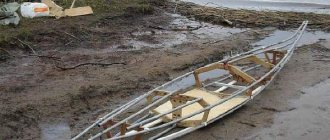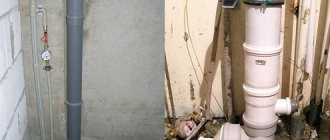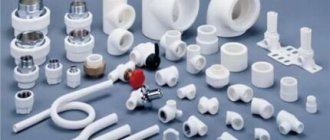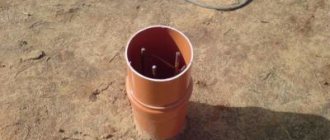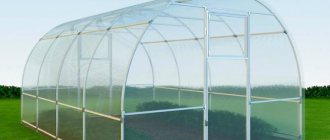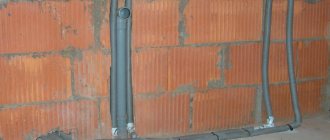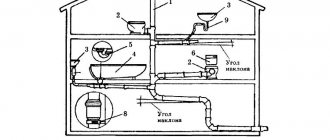Pipes have been used as a structural material for a long time and regularly.
They don’t make anything out of them. Plastic products were no exception, the reason for which was their technical characteristics, and in particular their resistance to rotting and corrosion, as well as the strength of the material. One of the ways to use these products was the manufacture of fences from plastic pipes. In our construction markets you can often find ready-made plastic fences of various types, from low, neat front gardens to high external fences. Their price is quite affordable and significantly lower than for pipes.
But often there are leftovers from construction, and if you accumulate them from neighbors and friends, you can quite easily collect them for a full-fledged fence. In addition, there are cases of mass rejection when it is impossible to use the pipes for their intended purpose and they can be purchased at a bargain price.
Let's assume that the developer has the required amount of material for the fence. How to make it?
Installation of pillars
The load-bearing structures of the fence are pillars to which lattice spans are attached.
Watch the video
How to install a FENCE POST FOREVER, Finnish Technology
For this, various profiles are used that are strong enough to withstand wind loads on the fence:
- galvanized steel pipes with a cross-section of 80 millimeters or more, round or profile;
- plastic ones ranging in size from 100-120 mm, as a rule, they need to be filled with concrete with reinforcement;
- reinforced cast concrete pillars;
- plastic poles, manufactured specifically for building fences;
- wooden pillars.
How to install poles step by step
First of all, it is necessary to calculate the number and size of spans. Their length determines the distance between the pillars. Then you need to proceed in the following order:
- Using a stretched cord, the line for installing the fence along the border of the summer cottage is determined.
- Pegs mark the location of the gate, gate and each support post.
- It is better to dig holes in the ground using a garden auger. Ideally, a drive device should be used. You don’t have to buy it; you can rent it for a daily fee.
- The depth of the pits should be greater than the freezing level of the soil. You can set this value on the Internet. This will ensure the immobility of the supports when the soil freezes.
- At the bottom of the pit it is necessary to arrange a cushion of a mixture of sand and gravel. It is needed to quickly drain water from the column during snow melting and heavy rainfall.
- All pillars must be filled with concrete no lower than to the ground level. Ideally, a strip foundation reinforced with a road mesh of 50x50 or 100x100 millimeters should be installed between the pillars. The width of the tape should be 40 centimeters with a depth of half a meter. After concreting is completed, the foundation must stand for at least seven days until the mass hardens.
- Fastening of finished spans is carried out locally, depending on the profile from which the supports are made.
Watch how to install a pillar for centuries.
How to install a FENCE POST FOREVER
Video on how to make a foundation.
Fence foundation
Installation of a plastic fence
Upon completion of the construction of the support posts, they must be equipped with longitudinal joists - connecting parts on which the fencing strips are attached. Their number and the distance between them in height depends on the design of the fence.
Watch the video
The principle of manufacturing a corner joint from polypropylene pipes for the frame of a side awning
For wicker fencing, there must be at least three joists. If there are pipes with a diameter of more than 80 millimeters, they can be split lengthwise into two halves and used in the same way as a traditional picket fence.
A popular design for fences is that they use pipes for the frame and mesh made of metal and plastic. They can be permanent or temporary, permanent or portable to highlight certain areas in the residential area of the courtyard of a country house.
The remains of plastic pipes will allow you to create a durable fence for your flower beds or beds.
The plasticity of the PVC material allows you to realize your wildest fantasies when creating an external fence for a site. Using fittings to their fullest extent, you can create amazingly beautiful compositions.
In an original way, you can fence a gazebo or a small area with vertical beds made of pipes.
For this purpose, products with a diameter of 100 millimeters are used, in the walls of which holes with a diameter of 25-30 millimeters are drilled. The pipes are dug vertically into the ground, filled with fertile soil, and plants are planted in the holes. It can be either strawberries or climbing plants.
See installation guide.
Plastic fence installation guide
Options for the design of fencing are limited only by the imagination of the performer, taking into account the available material.
Video on how to install.
Installation of plastic fence-lattice TM Kazachka
How to Install a Vinyl Picket Fence (part 1)
Preparatory work
Before installing a plastic fence, it is necessary to carry out preparatory work, which includes:
- a thorough examination of the area where the fence will be erected;
- deciding on the need to build a foundation or plinth;
- preparation of all necessary tools;
- marking the area using pegs and threads stretched between them.
In accordance with the markings, the installation locations of the pillars are marked. The distance between them depends on the width of the spans of the future fence.
Types of fencing made of plastic pipes
First of all, let us pay attention to the inevitable formation of a significant amount of short residues during the installation of a water supply system. This is not trash at all! They can be successfully used for making flower bed fences.
To install them, you need to dig a groove to a depth of half the average length of the remaining material. After this, the pipes are installed end-to-end on the bottom, filled with previously removed soil and thoroughly compacted.
Traces of work can be masked using removed turf, and the entire structure takes on an almost final appearance. If you install several rows of such fences at different levels, you can build a beautiful stepped flower bed.
To divide the space of the site into residential and economic zones, front gardens are installed - fences of small height. The rules for installing support pillars are the same as for installing a boundary fence - deepening below the freezing level of the soil.
For the front garden, the supports do not need to be concrete, since the wind loads on the low fence located in the middle of the site are small. In the process of backfilling the pit with the post, it is enough to fill it with medium-sized stones and thoroughly compact the earth. This arrangement of the pole will ensure its long-term operation.
A fence made of plastic pipes, made in the form of a fence, looks great and is functional. To do this, you need to have products with a diameter of 16-20 millimeters available.
But we must still admit that fences made of plastic pipes are expensive. Therefore, fencing options using plastic or metal mesh are more common.
It fills the space in the frame, which is the span of the fence, or it is simply stretched between the pillars. This is most often used on fences between areas.
For what purpose do they set
The installation of modern plastic fences solves various problems. A wide variety of plastic structures allows them to be used not only for fencing the territory, but also for internal zoning. Bright colors do not require additional decor.
Using a plastic fence, you can separate a children's playground, hide a vegetable garden area, or fence off beds and flower beds in your dacha. A plastic picket fence makes an original fence for a front garden.
Decor for plastic fencing
A fence made of plastic pipes, installed by yourself, is always original in design and in itself speaks about the inclinations and tastes of the owner. However, the modern construction market makes it possible to make it unique.
For this purpose, decorative elements are sold to solve this problem. The most popular finishing elements are floral patterns.
A real decoration for flower beds and flower beds are original crafts in old traditions, for example, a flower bed woven from vines
The easiest way to give a fresh, original look to a simple fence is to decorate it with living vegetation, for which climbing plants are used.
Advantages of plastic fences
Modern plastic materials have a number of undeniable advantages, which are as follows:
- The material is not subject to corrosion, which determines its long service life.
- The material is light in weight, which simplifies logistics operations and loading and unloading of material.
- During long-term operation there is no need for any maintenance in the form of painting or similar activities.
- Plastic materials are easily processed mechanically.
- Most plastics have strength characteristics sufficient for use as fencing.
If you compare plastic materials with their metal counterparts, you can immediately point out their obvious advantage. A metal fence requires constant care and maintenance, which is unusual for plastics.
Where can you install a plastic fence?
In principle, there are practically no restrictions on the use of plastic for fences. From the smallest parts to large blocks can be made from this material.
Plastic can be used to fence flower beds, or you can use it to make a palisade. Moreover, such materials are produced for a specific purpose. And often in designer execution.
However, not all materials are suitable for this purpose.
Polypropylene fence
The use of polypropylene for fencing, at first glance, is very technologically advanced if fittings are also used. A wide variety of grating shapes can be made from them, and completely original products are available using plastic decorative elements.
But let's remember some of the physical qualities of polypropylene.
The first obstacle. The material has a high coefficient of thermal linear expansion. In heating systems, this leads to sagging of long sections of water supply. If used to construct a fence, heating it in the sun will have the same effect.
For heating, this disadvantage was solved by reinforcing the material with fiberglass or aluminum. Any of these options reduces thermal expansion by 75%, which is enough for the material to function properly.
The second obstacle is the negative impact of hard ultraviolet radiation on the material. When exposed to sunlight, polypropylene becomes brittle.
Which can lead to structural failure. But they also learned to overcome this defect by adding up to 2% soot to the composition. This component gives the products a black color.
Thus, to install a fence made of polypropylene pipes, you need to use black reinforced products.
Let's take a closer look
It is not known exactly who first came up with the idea of building a fence from PVC pipes, but the idea found support among other consumers. This is largely due to the numerous positive characteristics of the material:
- durability. Polyvinyl chloride does not rot or be affected by insects, like wood, and does not rust like metal;
- resistance to various atmospheric phenomena (rain, frost, heat, temperature changes from -25 to +50˚С);
- ease of installation. PVC products are light in weight and can be easily assembled even by one person;
- ease of use. There is no need to lay a foundation under a plastic fence; it does not require additional processing (priming, painting);
- environmental friendliness. The polymers used to make the fence do not accumulate or emit toxic substances and do not harm people or the surrounding area;
- aesthetics. PVC pipes come in different colors, they do not fade in the sun, and a fence made from them looks presentable on both sides.
This is interesting: the service life of plastic fences is much longer than similar products made from other building materials. In the absence of natural disasters and emergencies, it is about 160 years.



